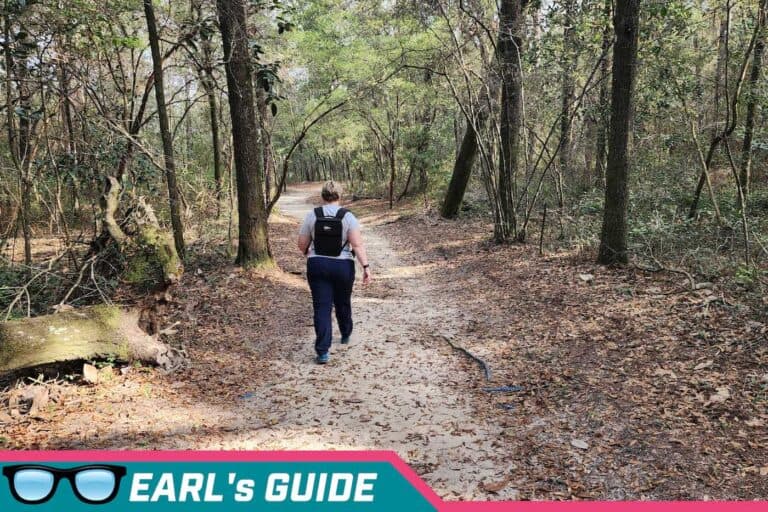Rucking is an excellent option if you enjoy workouts that challenge your cardiovascular endurance, strengthen your muscles and bones, and take you outside in nature. Popularized by the military, rucking involves carrying a loaded backpack while walking for a distance or time. However, knowing how to do it correctly and safely before starting this exercise is important.
This guide to rucking will provide you with all the necessary information to get started with rucking.
What is rucking?
Rucking is a physical activity that has gained popularity in recent years. We have an entire article answering the question What is Rucking? for you to read when you are finished with this guide.
It involves carrying weight on your back while walking or running.
This can be done alone or as part of a group and requires specific equipment – a backpack filled with evenly distributed weights like plates or sandbags.
5 Unique Aspects of Rucking
- Rucksacks come in various sizes
- Walking long distances with heavy weight improves endurance
- The military often uses rucking for training purposes
- Weighted plates can be added to the backpacks to vary this exercise
- Ruck marches last several hours and covers many miles
Rucking is a great way to improve your physical fitness and endurance.
It is a low-impact exercise that can be done by people of all ages and fitness levels.
Rucking is also a great way to get outside and explore your surroundings while working out.
“Rucking is a great way to improve physical fitness and endurance.”
Many people enjoy rucking because it is a challenging and rewarding workout.
It can also be a great way to bond with friends or meet new people who share your interest in fitness.
Rucking may be the perfect activity if you are looking for a new way to challenge yourself and improve your fitness.
Benefits of rucking
Rucking is a form of exercise that involves carrying weight on your back while walking.
It’s a low-impact exercise that’s easier on joints than running or jumping exercises. It is easy to get started rucking.
Rucking offers both physical and mental health benefits.
Physical Benefits of Rucking
- Strengthens muscles, including hamstrings, calves, quads, and glutes, with every step
- Improves cardiovascular endurance by recruiting more muscle groups than regular walking due to the added load on your body
- Burns calories without much struggle
Mental Benefits of Rucking
Rucking is not just a physical exercise. It also has mental health benefits.
It can help reduce stress and anxiety, improve mood, and boost self-confidence.
Rucking is a great way to clear your mind and get fresh air.
It’s a simple exercise that can significantly impact your overall well-being.
Whether you’re looking to improve your physical fitness or mental health, rucking is a great exercise to try.
Rucking is a simple yet effective way to improve your overall well-being.
How to choose a rucksack
Tips for Choosing the Right Backpack
Choosing the right backpack is crucial for successful rucking.
With so many options available, deciding which one suits you best can be overwhelming. Our Guide to the Best Backpacks for Rucking will help you make an informed derision.
Here are some tips:
1. Consider Your Needs
Choose a bag size based on how long your ruck marches will be and what gear you plan on carrying.
This will ensure you have enough space for all your essentials and won’t be weighed down by unnecessary items.
2. Prioritize Comfort
Ensure that the straps and back panel of the bag are padded to distribute weight evenly across your body, making longer distances more comfortable.
This will help prevent back pain and discomfort during your rucking sessions.
3. Look for Additional Features
Opt for multiple pockets/storage compartments and attachment points for external accessories like water bottles or sleeping bags to organize all necessary items during hikes or camping trips.
This will make accessing your gear more accessible and keep everything in its place.
Choosing an appropriate backpack ensures comfort and safety while enjoying outdoor activities!
So, if you’re wondering, is rucking good for you?
The answer is yes, as long as you have the right gear.
Choosing an appropriate backpack ensures both comfort and safety while enjoying outdoor activities!
Investing in a high-quality backpack is a smart choice for anyone who enjoys rucking.
What to pack for a ruck
What Gear Do You Need?
Packaging the right gear is crucial to have a successful and comfortable rucking experience.
Here’s what you may need:
- A sturdy backpack with padded straps and ample room
- At least 2 liters of water
- High-energy snacks like trail mix or protein bars
- Sunscreen and bug spray
- $20-40 cash for emergencies
- Extra socks to avoid wet feet
- An App designed for Rucking on your smartphone to help you track your ruck and find a trail.
Does Rucking Build Muscle?
If you’re looking for a challenging workout that can help you build muscle, rucking might be the answer.
But before you hit the trails, it’s important to make sure you have the right gear.
How Does Rucking Build Muscle?
Rucking is walking with a weighted backpack, and it is a great way to build muscle.
The added weight of the backpack increases the resistance of the workout, which can help you build strength and muscle mass.
When you ruck, you engage your entire body, including your legs, core, and upper body.
This can help you build muscle in all these areas and improve your cardiovascular endurance.
Conclusion
So, does rucking build muscle? Yes it does, when you consistently ruck with added weights.
Finding the right shoes or Boots for rucking
Tips for Choosing the Right Shoes or Boots
When rucking, proper shoes are crucial.
Your feet carry a lot of weight for an extended time and need support to reduce injury risk.
Here are five tips for choosing the perfect pair:
- Choose lightweight but durable materials.
- Ensure a comfortable fit with no tight spots.
- Check if they have removable insoles for replacement as needed.
- Aim for breathable material to prevent blisters and sweating.
- Look into specialized rucking shoes explicitly designed for this activity.
When finding the perfect pair, consider these things:
- Shoes should provide arch support and cushioning in heel and forefoot areas
- Non-slip soles grip surfaces without slipping or losing traction
- Try on your boots with the same socks that you plan on rucking in
Specialized Rucking Boots
If you’re serious about rucking, consider investing in specialized rucking boots.
The Earl’s Guide to the Best Boots designed for Rucking with help you make a choice.
These boots and shoes are designed specifically for this activity and provide the necessary support and durability.
They often have features such as:
- Extra cushioning in high-impact areas
- Reinforced soles for added durability
- Water-resistant materials to keep your feet dry
Proper form and posture when rucking
How to Start Rucking: Proper Form and Posture
Rucking is a great way to get in shape and build endurance.
However, it’s crucial to maintain proper form and posture to avoid injury.
Here are some tips to help you get started:
Stand Tall with your Head Up
When rucking, stand tall with your head up and shoulders slightly back.
This will help you maintain the correct posture and avoid straining your neck and back.
Engage Your Core
Engaging your core muscles throughout the exercise will help you maintain balance and stability.
This is especially important when carrying a heavy backpack.
Adjust Your Backpack Straps
Ensure your backpack straps are adjusted to sit high on your back and snugly against your body.
This will help distribute the weight evenly and prevent unnecessary strain on your shoulders and back.
Use Small Strides
Use small strides instead of long ones when walking or running with a backpack.
This will help you maintain balance and avoid joint strain.
Rucking vs. hiking similarities and differences
Rucking vs. Hiking: What’s the Difference?
Rucking and hiking involve walking for extended periods, but they differ significantly.
Rucking is a military-inspired activity where participants carry weighted backpacks. In contrast, hikers usually have light gear or no gear at all.
The Weight of the Backpack
The primary difference between rucking and hiking is the weight of the backpack.
A typical daypack used in hiking weighs around 5-15 pounds, whereas a rucksack can weigh up to 45 pounds.
Ruckers tend to focus on endurance training with heavier weights over longer distances than hikers do.
Five Differences Between Rucking vs. Hiking
- Terrain: Hiking trails tend to be marked with signs and better maintained than areas typically used for rucking.
- Intensity: Ruckers push themselves harder during workouts due to added weight resistance.
- Purpose: While both activities offer physical benefits such as cardiovascular health improvement and muscle strengthening, people often use them differently – some hike purely for leisure purposes, while others may choose it as an alternative form of transportation (e.g., commuting).
- Equipment Needed: In addition to carrying heavy loads on their backs when participating in this sport/activity type called racking, individuals also need specialized equipment like sturdy boots that provide ankle support & trekking poles which help maintain balance across uneven terrain surfaces encountered along routes taken by those who regularly engage within these types outdoor pursuits!
- Community Involvement/Competition Opportunities Available: There’s something about being part of a community that shares your passion!
- With events ranging from friendly competitions among friends/family members through organized races/events sponsored by companies specializing specifically towards enthusiasts interested primarily in either one particular pursuit mentioned above (hiking/racking), there’s always plenty of opportunity to get involved if you’re looking meet new people share common interests too!
Training with Sand Filled Items
Rucking is a great way to train with sand.
It’s a low-impact exercise that can help build strength and endurance.
Plus, it’s fun to get outside and explore new areas!
Whether you’re looking to train with sand or enjoy the great outdoors, rucking and hiking are excellent options.
Remember to choose the activity that best suits your goals and fitness level. Always be prepared with the right equipment and training plan.
Top places to go for a great ruck
Best Places for a Challenging Ruck
For an unforgettable rucking experience, choose from these top destinations:
- National Parks in the US: Yosemite and Yellowstone offer breathtaking scenery and challenging terrain to test your skills.
- Milford Track in New Zealand: Known as one of Australasia’s most beautiful and rewarding multi-day hikes.
- Rugged Wilderness Trails: Discover hidden gems tucked away among nature reserves at varying difficulty levels.
- Mountain Passes Brave steep mountain passes while taking in magnificent vistas.
Challenge yourself and your rucksack with these incredible locations.
Whether you’re a seasoned rucker or just starting out, these destinations offer something for everyone.
Rucking is not just a workout. It’s an adventure.
These destinations will take your rucking to the next level.
Experience the thrill of pushing yourself to new limits surrounded by stunning natural beauty.
Don’t settle for a boring workout routine – take your rucking to the great outdoors.
Rucking is the ultimate way to explore the world around you.
These destinations will leave you breathless in more ways than one.
Importance of hydration during a ruck
Stay Hydrated During Your Ruck with These Tips
Staying hydrated during a ruck is crucial to avoid fatigue and dehydration.
Physical activity like rucking can cause the human body to lose up to 2 liters of water per hour, so it’s essential to replenish fluids regularly.
Dehydration negatively impacts performance levels by causing muscle cramps, dizziness, lethargy, headaches, and other issues that could compromise your success in the ruck.
Be prepared with plenty of water or sports drinks for hydration during extended physical activity.
A good rule of thumb is to drink at least one liter every hour if you are engaged in high-intensity exercise.
Remember, staying hydrated is vital to a successful ruck.
Don’t let dehydration ruin your experience.
How to Ensure Proper Hydration
Follow these tips to ensure you stay hydrated during your ruck:
- Take regular sips throughout the day instead of waiting until the thirst sets in.
- Bring along water bottles or hydration packs in your rucksack. (We have reviewed and selected the Best Hydration Bladders for Rucking.)
- Monitor urine color – clear or light yellow indicates adequate fluid intake, while dark yellow means more fluids are needed.
- Avoid alcohol consumption before and after a long hike, as it dehydrates the body quickly.
- Consume foods rich in electrolytes, such as bananas, nuts & seeds, which help retain moisture within cells longer than plain water alone would do.
Remember, drinking water is not enough.
You need to consume foods rich in electrolytes to retain moisture within cells.
By following these tips, you can ensure that you stay hydrated during your ruck and avoid the adverse effects of dehydration.
Don’t let dehydration ruin your experience.
Stay hydrated and enjoy your ruck to the fullest!
Stay hydrated, stay safe, and have fun!
Adding weight to your rucksack
Effective Rucking Tips: How to Use Sandbags for Resistance Training
Adding weight to your rucksack is essential for effective rucking.
Start with 10-15 pounds and gradually increase the load over time.
Distribute weight evenly throughout your pack to avoid strain on any one area of your body.
Use a weighted plate or sandbag for additional resistance or items like Jerry Cans filled with sand.
5 Tips for Successful Rucking with Sandbags
- Start small: Increase load slowly to avoid injury.
- Distribute weight: Evenly distribute weight to prevent strain.
- Use weighted accessories: Consider using plates or bags for added resistance.
- Repurpose household items: Books can be used as weights if filled with sand/rocks.
- Stay consistent: Track your progress and stay committed to your routine.
Using sandbags for resistance training is an effective way to build strength and endurance.
By following these tips, you can ensure you are rucking safely and effectively.
Remember to start small, distribute weight evenly, and stay consistent with your routine.
You can increase your load and achieve your fitness goals with time and practice.
Using sandbags for resistance training is an effective way to build strength and endurance.
Whether you’re a beginner or an experienced rucker, incorporating sandbags into your routine can help you take your training to the next level.
Building endurance for longer-distance rucks
How to Pack a Ruck: Tips for Building Endurance and Improving Fitness
Building endurance is essential for rucking.
It enables you to cover longer distances with a heavy backpack without getting tired quickly.
Here are some tips on how to pack a ruck and improve your overall fitness:
Tip 1: Gradually Increase Mileage
To increase your endurance, gradually increase your weekly mileage by 10-15%.
Start slow and easy at first until you reach the desired distance.
Interval training can also help build stamina by alternating between high-intensity activities like running or speed walking and short recovery intervals.
Tip 2: Add Strength Exercises
Strength exercises such as lunges and squats can help improve your overall fitness and make rucking easier.
Incorporate these exercises into your workout routine to build up your leg muscles and improve your endurance.
Tip 3: Stay Hydrated
Staying hydrated is crucial when rucking.
Ensure you drink plenty of water before, during, and after your workout to prevent dehydration and fatigue.
Tip 4: Get Enough Sleep
Getting enough sleep is essential for recovery and overall fitness.
Aim for 7-8 hours of sleep each night to help your body recover and prepare for your next rucking workout.
Tip 5: Eat a Balanced Diet
A balanced diet rich in protein and carbohydrates can help fuel your body for rucking and improve your overall fitness.
Adjusting your pace while on a ruck
How to Ruck Safely and Comfortably with Boots
Rucking is a great way to stay fit and explore the outdoors.
However, it’s important to adjust your pace to avoid injury.
Here are some tips to help you ruck safely and comfortably with boots:
Adjust Your Pace
To avoid injury, adjust your pace while rucking.
Terrain, backpack weight, and weather conditions should dictate the speed.
Slow down and take shorter steps for uphill or rough terrain with heavy weights.
Adjust the pace by increasing or reducing arm movements as needed.
On easy trails with lighter loads, maintain a consistent rhythm for balance between momentum and control over load placement.
Pacing Tips
Consider these additional pacing tips:
- Experiment with different paces before settling on one
- Stay in sync with group members while maintaining an individual comfort level
- Adjust to environmental factors like temperature changes
- Maintain proper posture throughout the cycle
- Regularly monitor breathing rate
By following these tips, you can ruck safely and comfortably with boots.
Remember to always listen to your body and adjust your pace accordingly.
Happy rucking!
Are ruck marches bad for you?
Incorporating strength training with your ruck workouts
5 Tips to Incorporate Strength Training
Rucking is a great way to improve your overall fitness.
But did you know that incorporating strength training with ruck workouts can increase muscle mass, endurance, and overall fitness?
This creates a more robust body that handles life’s demands better.
To add strength training to your routine, try squats, deadlifts, and lunges with weights on your back.
It challenges muscles while providing weight resistance for calorie burn during exercise and throughout the day.
Also, try balance work like standing on one leg holding something stable for core stability, improving dynamic movement quality when navigating uneven terrain.
5 Tips to Start Incorporating Strength:
- Start with bodyweight exercises like push-ups, pull-ups, and planks
- Gradually add weight to your exercises to challenge your muscles
- Focus on compound exercises that work for multiple muscle groups at once
- Don’t forget to stretch before and after your workouts to prevent injury
- Track your progress to stay motivated and see results
Remember, rucking is good for you, but adding strength training to your routine can take your fitness to the next level.
So, start incorporating these tips into your workouts today and see the difference it makes!/
Rucking in different weather conditions
How to Pack a Ruck for Different Weather Conditions
Preparing for different weather conditions is crucial to succeeding in rucking.
Don’t let unexpected weather ruin your ruck.
Here are some tips to help pack your ruck for different weather conditions.
Hot and Sunny Weather
When rucking in hot and sunny weather, it’s important to wear breathable clothes and carry electrolyte water.
Protect your face from sunburn with a hat or visor.
- Wear breathable clothes
- Carry electrolyte water
- Protect your face with a hat or visor
Cold or Wet Weather
In cold or wet weather, dress in layers you can adjust as needed during your ruck.
Cover exposed skin with gloves and neck gaiters to prevent windburn.
- Dress in layers
- Adjust layers as needed
- Cover exposed skin with gloves and neck gaiters
Additional Tips
Here are some additional tips to help you pack your ruck for different weather conditions:
Use microspikes when walking on snowy/icy terrain.
Recovery tips after a long or intense ruck
Congratulations on completing a long or intense ruck!
Now, focus on recovery to minimize soreness and avoid injuries.
Start with light stretching after your workout to release muscle tension.
Then, take an ice bath for 10-15 minutes to reduce inflammation.
Stay hydrated by drinking plenty of water during and after the ruck.
This prevents cramps.
Use a foam roller to massage tight areas and stimulate blood flow for faster healing.
5 Tips for Ruck Recovery
- Refuel with protein-rich foods within 30 minutes of finishing.
- Get at least seven hours of sleep every night.
- Take rest days.
- Consider active recovery exercises like yoga or swimming.
- Avoid alcohol as it dehydrates you further.
Did you know? A ruck is a military term for a backpack.
Rucking is walking with a loaded pack for exercise or training purposes.
Proper recovery is essential after a ruck. Remember that adequate recovery is crucial in preventing injury and improving performance in future workouts!
It helps prevent injuries and improves performance in future workouts.
Safety precautions for solo or group rucks
Tips for Safe and Enjoyable Rucks
Rucking is a great way to get in shape and explore the outdoors.
However, safety should always be a top priority.
Here are some tips to help you start rucking:
Prioritize Safety
- Inform someone of your destination and expected return time for solo trips
- Carry a fully charged phone
- Wear reflective gear before sunrise or after sunset
- Stay aware of the surroundings
- Bring enough water and snacks
Group Rucks
Going out in groups can enhance safety and enjoyment.
Here are some tips for group rucks:
- Ensure everyone carries their own weight to avoid overburdening anyone else
- Stick together as much as possible
- Don’t leave behind members who may fall back due to low fitness levels
- Take breaks periodically
Remember, safety first!
Always be prepared and aware of your surroundings.
Now that you know how to start rucking safely, get out there and enjoy the great outdoors!
Rucking gear and equipment you may need
Proper Gear for Rucking
To ruck effectively, proper gear is crucial.
The necessary equipment depends on the duration of your session and the terrain.
- Invest in shoes or boots designed for rucking or running to support your feet during weight-bearing exercise.
- Wear moisture-wicking clothing that’s comfortable and breathable too.
- A backpack with padded straps will distribute weight evenly across your back while preventing chafing.
- If you’re planning long distances without water sources nearby, consider a hydration bladder system.
- Other helpful pieces of gear include gloves for grip strength when carrying heavy weights; compression socks to improve blood flow in legs; trekking poles (especially handy uphill); headlamps or flashlights for nighttime use.
Remember, the right gear can make all the difference in your rucking experience.
Investing in quality gear will make your rucking experience more comfortable and help prevent injuries.
Please don’t skimp on gear, or you may regret it later.
Choose gear that fits well and is appropriate for the terrain you’ll be rucking on.
Mental benefits of regular, consistent rucking
Is Rucking Good for You?
Regular rucking has numerous mental benefits that improve overall well-being.
It boosts mood and reduces stress levels by releasing endorphins, natural chemicals produced by the brain to reduce pain and enhance mood.
- Boosts mood
- Reduces stress levels
- Enhances cognitive functions
- Provides opportunities for alone time or bonding with others
- Improves mental toughness
- Sharpens focus on tasks at hand
- Relieves personal stress
- Provides opportunities to engage with others
Rucking enhances cognitive functions like memory retention, learning ability, and critical thinking skills crucial for daily life activities such as work or school assignments.
It also reduces social isolation when done in teams.
Regular ruck training is an excellent way to relieve personal stress while providing opportunities to engage with others.
Rucking is a great way to get outside, exercise, and clear your mind.
It’s a simple activity that can significantly impact your mental health.
The benefits are clear whether you’re rucking alone or with a group.
A few benefits of regular ruck training are improved mental toughness and sharpened focus on tasks at hand.

Robert Earl
Robert EarlRobert has 20+ years of experience as a Real Estate Agent, Coach & Digital Marketer. Robert Earl is passionate about teaching and empowering others to pursue their dreams and create sustainable income. Whether through a career in real estate, affiliate marketing, niche blogging, or transforming campgrounds into thriving communities, his proven strategies and techniques have helped numerous individuals and businesses succeed. Based on his years of experience and knowledge in the online marketing industry, along with his hands-on management in the Real Estate & RV Park sector, he has crafted a unique and effective approach to personal and professional growth. In addition to his business pursuits, Robert is also a CrossFit Online Level 1 Trainer (CF-OL1) and enjoys fitness activities, including Rucking workouts while traveling the country. His multifaceted career showcases his dedication to growth, innovation, and the pursuit of excellence in various domains.






